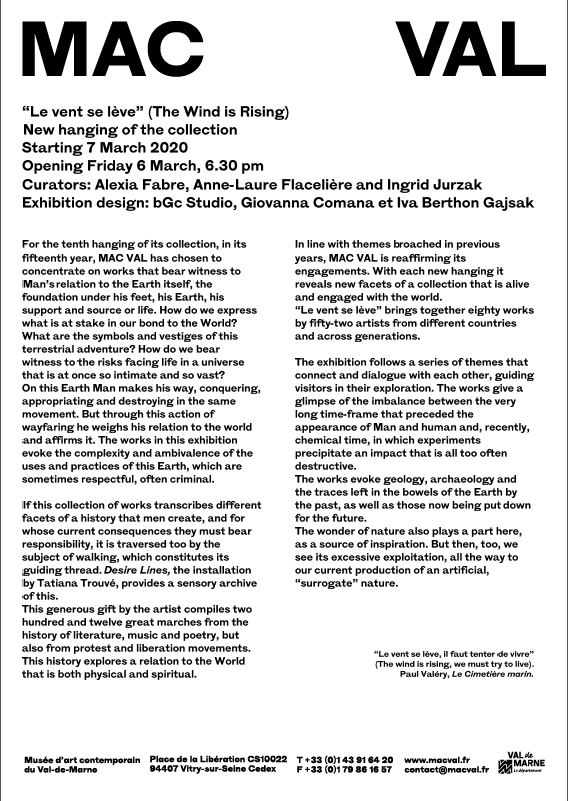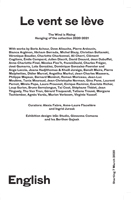For the tenth hanging of its collection, in its fifteenth year, MAC VAL has chosen to concentrate on works that bear witness to Man’s relation to the Earth itself, the foundation under his feet, his Earth, his support and source or life. How do we express what is at stake in our bond to the World? What are the symbols and vestiges of this terrestrial adventure? How do we bear witness to the risks facing life in a universe that is at once so intimate and so vast?
On this Earth Man makes his way, conquering, appropriating and destroying in the same movement. But through this action of wayfaring he weighs his relation to the world and affirms it. The works in this exhibition evoke the complexity and ambivalence of the uses and practices of this Earth, which are sometimes respectful, often criminal.
If this collection of works transcribes different facets of a history that men create, and for whose current consequences they must bear responsibility, it is traversed too by the subject of walking, which constitutes its guiding thread. Desire Lines, the installation by Tatiana Trouvé, provides a sensory archive of this.
This generous gift by the artist compiles two hundred and twelve great marches from the history of literature, music and poetry, but also from protest and liberation movements. This history explores a relation to the World that is both physical and spiritual.
In line with themes broached in previous years, MAC VAL is reaffirming its engagements. With each new hanging it reveals new facets of a collection that is alive and engaged with the world.
“Le vent se lève” brings together eighty works by fifty-two artists from different countries and across generations.
The exhibition follows a series of themes that connect and dialogue with each other, guiding visitors in their exploration. The works give a glimpse of the imbalance between the very long time-frame that preceded the appearance of Man and human and, recently, chemical time, in which experiments precipitate an impact that is all too often destructive.
The works evoke geology, archaeology and the traces left in the bowels of the Earth by the past, as well as those now being put down for the future.
The wonder of nature also plays a part here, as a source of inspiration. But then, too, we see its excessive exploitation, all the way to our current production of an artificial, “surrogate” nature.
Finally, here are ancient and modern rituals that are one with nature, and collectives that are acting to denounce and fight the blindness of current powers: the power of “us” against “me” carries the hope of a commonality of things, in opposition to extreme individualism and the race for quick profit, championing another, vitally rooted way of inhabiting the Earth.
“Le vent se lève, il faut tenter de vivre” (“The wind is rising, we must try to live”). Paul Valéry, Le Cimetière marin.
With works by :
Boris Achour, Dove Allouche, Pierre Ardouvin, Bianca Argimon, Hicham Berrada, Michel Blazy, Christian Boltanski, Véronique Boudier, Charlotte Charbonnel, Ali Cherri, Clément Cogitore, Émile Compard, Julien Discrit, David Douard, Jean Dubuffet, Anne-Charlotte Finel, Nicolas Floc’h, franckDavid, Charles Fréger, José Gamarra, Lola González, Dominique Gonzalez-Foerster and Ange Leccia, Joana Hadjithomas & Khalil Joreige, Benoît Maire, Pierre Malphettes, Didier Marcel, Angelika Markul, Jean-Charles Massera, Philippe Mayaux, Bernard Moninot, Roman Moriceau, Jean-Luc Moulène, Tania Mouraud, Jean-Christophe Norman, Gina Pane, Laurent Pernot, Mirela Popa, Laure Prouvost, Enrique Ramírez, Evariste Richer, Loup Sarion, Bruno Serralongue, Tal Coat, Stéphane Thidet, Jean Tinguely, Thu Van Tran, Gérard Traquandi, Tatiana Trouvé, Morgane Tschiember, Agnès Varda, Marion Verboom, Virginie Yassef.


Et lorsque le vent se lève, il faut tenter de vivre !

